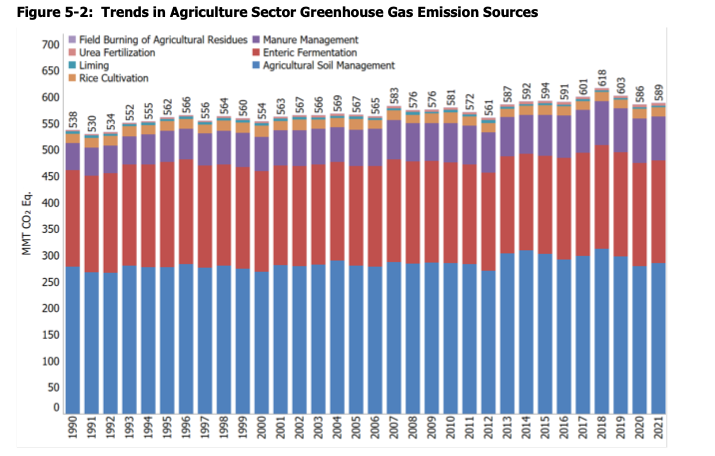Agriculture greenhouse gas pollution has risen steadily in the last 30 years, in spite of misinformation peddled by the Industrial Agriculture lobby.
EPA data shows that the increase comes primarily from additional nitrogen fertilizer and the shift toward factory farm-produced dairy, beef cattle, and hogs.
The U.S. Environmental Protection Agency (EPA) recently released its annual report documenting trends in greenhouse gas (GHG) emissions, finding a 6% increase in 2021 from the pandemic-haunted 2020. The U.S. economy rebounded from the COVID-19 pandemic in 2021, causing an increase in fossil fuel combustion.
Agriculture GHG pollution continued its steady long-term contribution, making up 9.3% of overall U.S. emissions, according to EPA. The vast majority of farming emissions come from nitrogen fertilizer and tillage, enteric fermentation by cattle, and liquid manure generated by industrial livestock factories.
“The data shows a continued increase in GHG emissions from agriculture, not by CO2 as much, but by large increases in methane and nitrous oxide,” said Ben Lilliston, Director of Rural Strategies and Climate Change at the Institute for Agriculture and Trade Policy (IATP). “The EPA attributes the rise to a shift in livestock production away from traditional family farms to CAFOs [Concentrated Animal Feeding Operations], as well as increased use of nitrogen fertilizer.”
The EPA data contradicts regular misinformation spouted by corporate agribusiness, the Farm Bureau, commodity-funded checkoff groups like the National Cattlemen’s Beef Association, members of Congress, and the U.S. Department of Agriculture, who paint a false picture of “production agriculture” as “climate smart.”
Last year, the Farm Bureau generated a Market Intel report highlighting these talking points. The accompanying press release, titled “America’s Farmers are Reducing Greenhouse Gas Emissions,” failed to mention the 2020 pandemic-induced emission decline. The agriculture lobbying group did not release a similar report this year as agriculture emissions rose.
Lilliston said that this year’s report contained important information about industrial livestock production and the vast amounts of liquid manure generated by CAFO dairy, cattle, and hogs. “CAFOs produce way too much manure, more than can be used on local farms. That means climate pollution from gasses, and also severe water pollution caused by overapplication of manure leading to runoff.”
“The data shows that loss of independent family farms raising livestock on pastures and in traditional methods has had a climate impact,” said Lilliston. “Livestock production controlled by [meatpacking giants] Smithfield, JBS, Tyson, and others is a clear climate risk.”
The EPA report singles out the consequences of the shift in dairy production to CAFOs, documenting a 13% rise in dairy cattle methane emissions since 1990, even as the dairy cattle population declined by 3.5%. That increase is linked to a shift toward liquified manure systems on these large CAFOs.
The report states:
“While national dairy animal populations have decreased since 1990, some states have seen increases in their dairy cattle populations as the industry becomes more concentrated in certain areas of the country and the number of animals contained on each facility increases. These areas of concentration, such as California, New Mexico, and Idaho, tend to utilize more liquid-based systems to manage (flush or scrape) and store manure. Thus, the shift toward larger dairy cattle and swine facilities since 1990 has translated into an increasing use of liquid manure management systems, which have higher potential CH4 emissions than dry systems…In many cases, manure management systems with the most substantial methane emissions are those associated with confined animal management operations where manure is handled in liquid-based systems.”
CAFO dairies present additional risks as well. A recent explosion at the massive 40-acre South Fork Dairy in Dimmitt, Texas, killed approximately 18,000 dairy cows and one person. Though an investigation is still underway to determine what caused the explosion, signs point to South Fork Dairy’s development of a “renewable natural gas” (RNG) production system with partner Clean Energy Fuels Corporation. The project was projected to produce 2.9 million gallons of RNG per year.
Biogas from liquid CAFO manure is one of the cornerstones of Secretary of Agriculture Tom Vilsack’s “Climate Smart Commodities” Initiative. Prior to returning as head of USDA, Vilsack served as an executive for the Dairy Export Council.
Lilliston said factory farm biofuels and methane digesters are a false climate solution, and that the agribusiness spin on GHG pollution trends is misleading. “The climate doesn’t care about your public relations messaging. The climate cares whether climate pollution is going up or down.”
The Cocklebur covers rural policy and politics from a progressive point-of-view. Our work focuses on a tangled rural political reality of dishonest debate, economic and racial disparities, corporate power over our democracy, and disinformation peddled by conservative media outlets. We aim to use facts, data, and science to inform our point-of-view. We wear our complicated love/WTF relationship with rural America on our sleeve.





